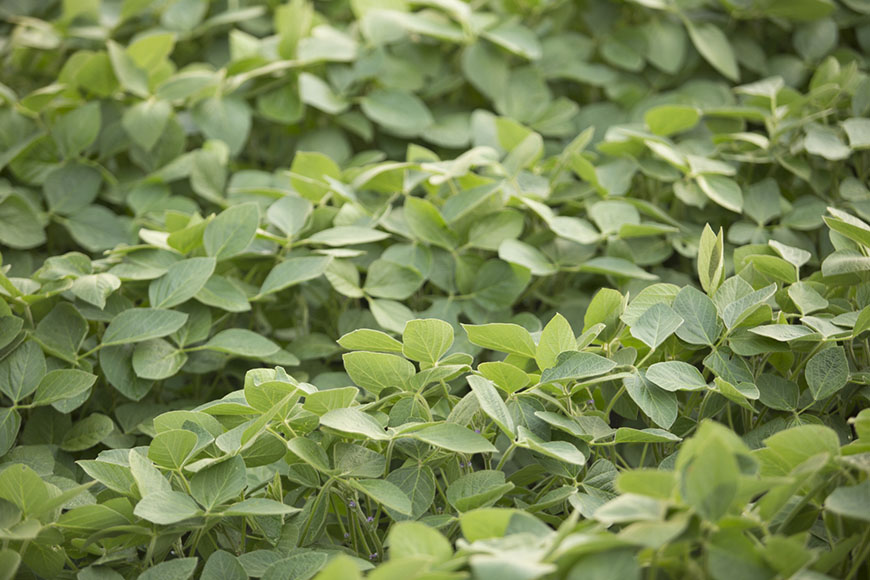Nourishing Soybeans at Key Stages

Unlike corn, soybean plants have only a small area in which to store nutrients, making them more susceptible to in-season shortages. Here are some tips for ensuring your soybean plants are adequately fed all season long.<br />
<br />
<strong>Manganese for efficient photosynthesis</strong><br />
As the soybean plant approaches flowering (V3 to V5), take a tissue sample to help identify low levels of manganese and other essential plant nutrients. Maintaining a sufficient level of manganese during this stage produces more flowers and a healthier plant going into the reproductive stage.<br />
<br />
<strong>Replenish low nitrogen </strong><br />
A tissue sample taken between V3 and V5 will also tell you if the plant has sufficient nitrogen to fully support flower production. If the tissue sample indicates low nitrogen, dig up a few plants, cut open the nodules, and check for a healthy pink to red color to ensure they’re producing nitrogen. If the color is white, brown or green, nitrogen fixation is not occurring.<br />
<br />
In a high-yield environment that produce 65 bushels per acre or more, a yield response has been seen with nitrogen applications at R1 to R3 to supplement nitrogen-fixing nodules. In average yield environments that support up to 55 bushels per acre, soybeans may not require additional nitrogen. The tissue sample can also help you make a decision about whether or not nitrogen supplementation is needed.<br />
<br />
<strong>Monitor ongoing nutrient needs</strong><br />
As the reproductive stage progresses, manganese continues to play an important role in maintaining efficient photosynthesis throughout the season. In addition, an adequate supply of boron will help keep flowers and pods healthy longer. You should also monitor calcium and potassium to support ongoing plant health.<br />
<br />
Tissue sampling between R1 and R3 will identify any micronutrient shortages while there’s still time to make supplemental applications and protect yield potential.<br />
<br />
<strong>Stave off disease</strong><br />
Keeping plant leaves disease-free allows the maximum amount of photosynthesis. Diseases such as frogeye leaf spot or brown spot can prohibit adequate sunlight from entering the plant.<br />
<br />
A fungicide application during the R1 to R3 stage not only prevents leaf diseases, it helps the plant use water more efficiently and better tolerate dry conditions.<br />
<br />
For more information about soybean management for your area, contact your local agronomist.<br />
<br />
<br />
<strong>Quick tips for soybean health</strong>
<ol>
<li>Maintain manganese levels to help increase the efficiency of photosynthesis.</li>
<li>Take a tissue sample to measure nitrogen levels.</li>
<li>Monitor ongoing nutrient needs to protect yield potential.</li>
<li>Keep soybeans free of disease to allow the maximum amount of photosynthesis. </li>
</ol>
<br />
<strong>Manganese for efficient photosynthesis</strong><br />
As the soybean plant approaches flowering (V3 to V5), take a tissue sample to help identify low levels of manganese and other essential plant nutrients. Maintaining a sufficient level of manganese during this stage produces more flowers and a healthier plant going into the reproductive stage.<br />
<br />
<strong>Replenish low nitrogen </strong><br />
A tissue sample taken between V3 and V5 will also tell you if the plant has sufficient nitrogen to fully support flower production. If the tissue sample indicates low nitrogen, dig up a few plants, cut open the nodules, and check for a healthy pink to red color to ensure they’re producing nitrogen. If the color is white, brown or green, nitrogen fixation is not occurring.<br />
<br />
In a high-yield environment that produce 65 bushels per acre or more, a yield response has been seen with nitrogen applications at R1 to R3 to supplement nitrogen-fixing nodules. In average yield environments that support up to 55 bushels per acre, soybeans may not require additional nitrogen. The tissue sample can also help you make a decision about whether or not nitrogen supplementation is needed.<br />
<br />
<strong>Monitor ongoing nutrient needs</strong><br />
As the reproductive stage progresses, manganese continues to play an important role in maintaining efficient photosynthesis throughout the season. In addition, an adequate supply of boron will help keep flowers and pods healthy longer. You should also monitor calcium and potassium to support ongoing plant health.<br />
<br />
Tissue sampling between R1 and R3 will identify any micronutrient shortages while there’s still time to make supplemental applications and protect yield potential.<br />
<br />
<strong>Stave off disease</strong><br />
Keeping plant leaves disease-free allows the maximum amount of photosynthesis. Diseases such as frogeye leaf spot or brown spot can prohibit adequate sunlight from entering the plant.<br />
<br />
A fungicide application during the R1 to R3 stage not only prevents leaf diseases, it helps the plant use water more efficiently and better tolerate dry conditions.<br />
<br />
For more information about soybean management for your area, contact your local agronomist.<br />
<br />
<br />
<strong>Quick tips for soybean health</strong>
<ol>
<li>Maintain manganese levels to help increase the efficiency of photosynthesis.</li>
<li>Take a tissue sample to measure nitrogen levels.</li>
<li>Monitor ongoing nutrient needs to protect yield potential.</li>
<li>Keep soybeans free of disease to allow the maximum amount of photosynthesis. </li>
</ol>

